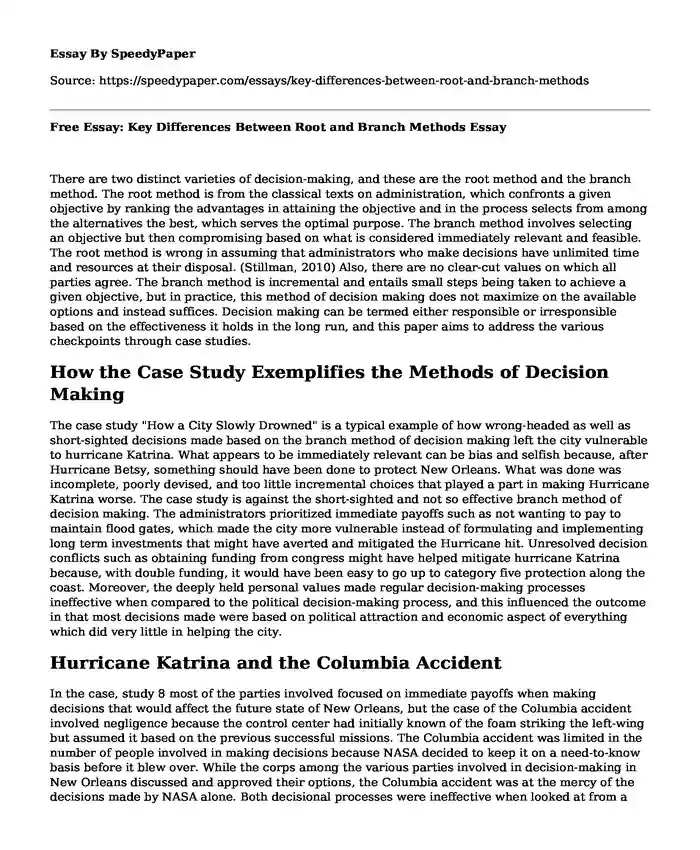
| Type of paper: | Critical thinking |
| Categories: | Social psychology Public administration Leadership management |
| Pages: | 3 |
| Wordcount: | 708 words |
There are two distinct varieties of decision-making, and these are the root method and the branch method. The root method is from the classical texts on administration, which confronts a given objective by ranking the advantages in attaining the objective and in the process selects from among the alternatives the best, which serves the optimal purpose. The branch method involves selecting an objective but then compromising based on what is considered immediately relevant and feasible. The root method is wrong in assuming that administrators who make decisions have unlimited time and resources at their disposal. (Stillman, 2010) Also, there are no clear-cut values on which all parties agree. The branch method is incremental and entails small steps being taken to achieve a given objective, but in practice, this method of decision making does not maximize on the available options and instead suffices. Decision making can be termed either responsible or irresponsible based on the effectiveness it holds in the long run, and this paper aims to address the various checkpoints through case studies.
How the Case Study Exemplifies the Methods of Decision Making
The case study "How a City Slowly Drowned" is a typical example of how wrong-headed as well as short-sighted decisions made based on the branch method of decision making left the city vulnerable to hurricane Katrina. What appears to be immediately relevant can be bias and selfish because, after Hurricane Betsy, something should have been done to protect New Orleans. What was done was incomplete, poorly devised, and too little incremental choices that played a part in making Hurricane Katrina worse. The case study is against the short-sighted and not so effective branch method of decision making. The administrators prioritized immediate payoffs such as not wanting to pay to maintain flood gates, which made the city more vulnerable instead of formulating and implementing long term investments that might have averted and mitigated the Hurricane hit. Unresolved decision conflicts such as obtaining funding from congress might have helped mitigate hurricane Katrina because, with double funding, it would have been easy to go up to category five protection along the coast. Moreover, the deeply held personal values made regular decision-making processes ineffective when compared to the political decision-making process, and this influenced the outcome in that most decisions made were based on political attraction and economic aspect of everything which did very little in helping the city.
Hurricane Katrina and the Columbia Accident
In the case, study 8 most of the parties involved focused on immediate payoffs when making decisions that would affect the future state of New Orleans, but the case of the Columbia accident involved negligence because the control center had initially known of the foam striking the left-wing but assumed it based on the previous successful missions. The Columbia accident was limited in the number of people involved in making decisions because NASA decided to keep it on a need-to-know basis before it blew over. While the corps among the various parties involved in decision-making in New Orleans discussed and approved their options, the Columbia accident was at the mercy of the decisions made by NASA alone. Both decisional processes were ineffective when looked at from a long-term viewpoint because they partly contributed to making the disasters worse.
The Role of Personal Values and Other Political Pressures Play
Personal values of individuals and groups lay a vital role in the making of public decisions, and so does appropriate timing and political pressures. It is because everyone has different interests in every decision that is made and when the parties strive to win by having their interests fulfilled, this tends to dictate the outcome of the decisions massively. The government encompasses a number of bodies and interest parties who have different interests in the outcome of the decision process. Inclusion of some relevant party may assist in establishing an objective decision which may not come about if the party is not included. Moreover, because the government is involved in making public decisions, including few parties in the decision-making process, it can be helpful as it becomes easy to focus on the long term effect of a decision rather than the pressing temporary outcomes.
Reference
Stillman, R. J. (2010). Public administration: Concepts and cases. Belmont, CA: Wadsworth Cengage Learning.
Cite this page
Free Essay: Key Differences Between Root and Branch Methods. (2023, Feb 22). Retrieved from https://speedypaper.com/essays/key-differences-between-root-and-branch-methods
Request Removal
If you are the original author of this essay and no longer wish to have it published on the SpeedyPaper website, please click below to request its removal:
- Free Essay: Recommended PPM-based Growth Strategies for Wedding SMEs in Korea
- Reaction Paper Example on the Freedom Writers Movie
- Disparities in Education, Essay Example
- Free Essay on Gerontology and Physical Health
- Racism in the Medical Field, Essay Sample for Everyone
- Paper Example: The Recommendations for the Rewards of Delta Airlines
- Patient Protection and Affordable Care Act (PPACA) - Free Essay in Healthcare Policy
Popular categories




